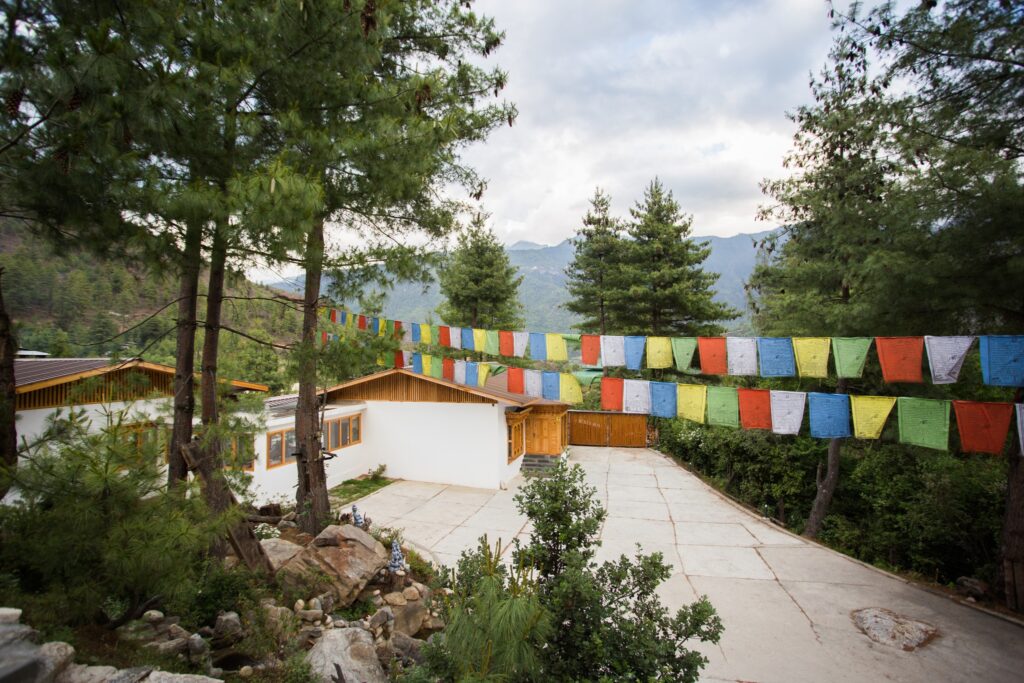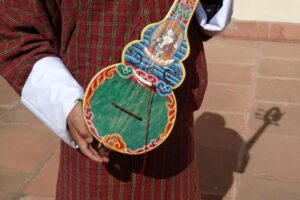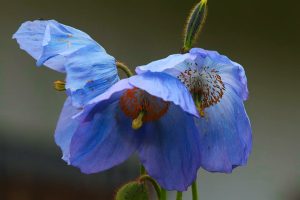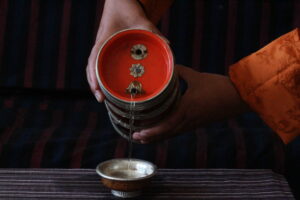
As you explore the mountain landscapes of Bhutan, you can’t miss the vibrant strings of colorful flags fluttering gracefully in the breeze. These are the famous prayer flags, an ancient Buddhist tradition rich with spiritual meaning. For centuries, the faithful have printed sacred mantras and invocations onto these flags, believing the wind carries the blessings far and wide.
In Bhutan, prayer flags manifest in various styles reflecting local customs. Some hang vertically from tall poles planted into the earth, while others stretch horizontally between ropes, adorning bridges or fluttering at high mountain passes. The designs range from the ubiquitous “Om Mani Padme Hum” to mantras like “Vajra Guru” for overcoming obstacles or prayers increasing one’s “lung-ta” or wind-horse of fortune. Sizes and types vary, but all bear the sacred aspirations of the faithful.
Diverse Types of Prayer Flags in Bhutan
While united by their sacred purpose, prayer flags in Bhutan take on a variety of styles reflecting local customs and intentions:
Lungdar are the square or rectangular colored flags hung horizontally or diagonally, connected along the top edges on strings between wooden poles or ropes. These vibrant lungdhars are ubiquitous across Bhutan – at mountain passes, bridges, monasteries and stupas.
Dachog, locally known as darshing, are the tall vertical flags clustered on poles planted directly into the ground, often found in groups around mountains and forests.
Manidar are the tall white vertical flags raised singly on poles, typically after someone has passed away as a remembrance for the deceased. Hoisting 108 (an auspicious number) manidhar is considered highly blessed, though even one holds profound meaning.
Lhadar are the large, tall, vertical flags bearing printed mantras like “Om Mani Padme Hum” and others. Displayed at important monasteries and palaces, they represent victory over evil forces and are often topped with a Gyeltshen banner instead of the traditional sword, sun, moon emblems. Nowadays, people often hoist one large lhadhar flag rather than many smaller ones.
Goendar are small white rectangular flags placed atop traditional homes, with ribbons of green, red, yellow, and blue adorning the edges, calling blessings of welfare, prosperity, and harmony for the family within.
The cylindrical Gyeltshen Tsemo banner, printed with mantras and the eight auspicious signs, is used in rituals and religious processions as a proclamation of victory over evil, even appearing at archery competitions after a match.
The Symbolism in Color
Each flag bares a distinct vivid hue, not chosen arbitrarily, but imbued with symbolic representation of the five elements and human emotions.
- Brilliant white flags embody the air and purity, while ethereal blue evokes the sky and good health.
- A verdant green represents the cleansing flow of water and compassion.
- Golden yellow connects to the grounding element of earth and the victorious overcoming of challenges.
- The vibrant crimson red evokes the perpetual spark of fire and the fulfillment of heartfelt wishes.
Even the small stripes on the prayer flags represent five colors, symbolizing the five elements. At the top of the Bhutanese flagpole, there is a sword signifying the wisdom of Mañjuśrī, resting upon a sun and moon disc, with a lotus flower and a wheel (khorlo) below it.
Flag Creation Process
Just as there are specific types of Bhutanese prayer flags, there are also traditional protocols surrounding where and how they should be displayed and cared for out of reverence:
The creation process itself holds spiritual significance. Printers produce the flags in a consecrated space through meticulous methods, so that each sacred syllable appears flawlessly. Once complete, the flags are hoisted at spiritually resonant locations – high mountain passes, monasteries, even across village rooftops – to catch the winds and spread the blessings far.
While some debate remains around whether the printed mantras should face inward or outward, all agree the proper orientation, hanging neither crooked nor upside down, is paramount when raising the flags with intentional respect.
In keeping with Buddhist values, using biodegradable, environmentally-friendly materials honors the interdependent natural world through which the prayers journey. Some formally consecrate the flags through ritual before or after raising them, though the sacred words hold power.
When the prayers inevitably fade from sun exposure and wind, the flags are ceremonially retired rather than letting them fall and be defiled. Through sacred burning rites, the old flags’ spiritual energies are released before replacing them with new strings, allowing this timeless tradition to carry forth.
At the top of the Bhutanese flagpole for smaller flags, there is a sword signifying the wisdom of Mañjuśrī, resting upon a sun and moon disc, with a lotus flower and a wheel (khorlo) below it.
Devoted Thoughts When Hoisting Prayer Flags
For Bhutanese, prayer flags hold profound spiritual significance. The sincere intention is for the dharma’s blessings to be carried across the lands and through the skies, reaching every village, valley, river and mountain, pacifying suffering and allowing all beings, whether on land, in water or in air, to ultimately attain happiness and enlightenment.
For as long as the majestic Himalayas have towered over these lands, the sacred prayer flags of Bhutan have adorned the mountains and valleys with their colorful blessings upon the wind.



